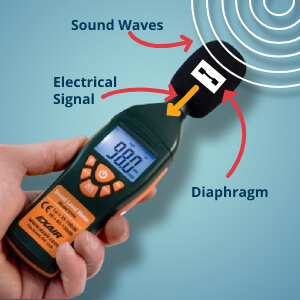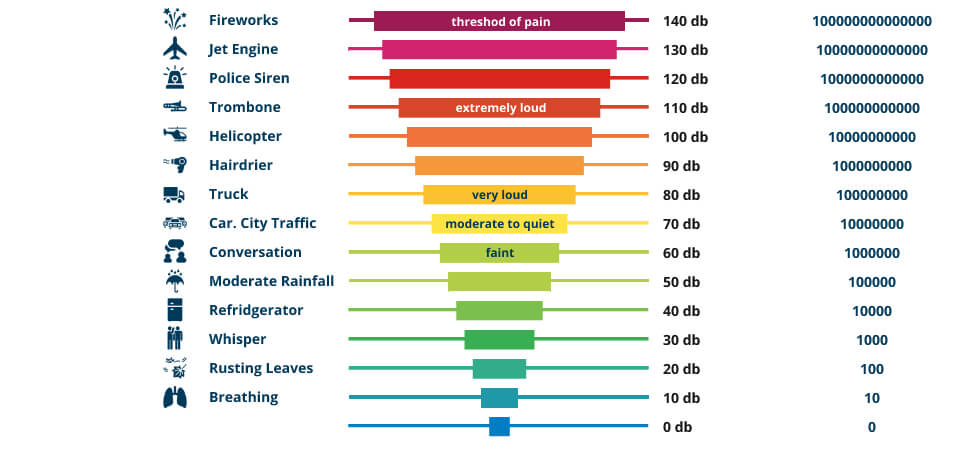- Show results for
- Share
How to Measure Sound?

How loud we can perceive the sound refers to the amount aspects such as intensity, volume, duration, frequency, and amplitude.
The sound intensity, or as it is also called sound pressure, is measured in decibels (dB). For a better explanation of how we get the sound intensity, the scale of decibels is numerical.
The decibels scale demonstrates the sound intensity according to the human ear reaction. In this case, the decibel scale is generally used to explain the recommendations of the sound level.
How Is Sound Produced?

When you bang a drum it vibrates. The harder you bang the drum, the bigger the vibrations are. The drum skin that provides vibrations makes the nearby air particles vibrate. Such vibrating particles produce sound waves.
When the electricity goes through a speaker, the diaphragm vibrates and provides sound waves, as by the example of a drum.
Sound waves pass at 343 m/s through the air and faster through the solids and liquids. These waves transmit energy from the sound source, for instance, a drum, to its surroundings. The human ear determines the sound waves when the air particles that vibrate make your eardrum vibrate. The bigger the vibration, the louder the sound.
What is a Decibel Level?
The decibel (dB) is a measurement unit that is used to determine the intensity of the sound. On the decibel scale, silence is equal to 0 dB. A sound that is 10 times more powerful is equal to 10 dB. The sound that is 100 times powerful equals 20 dB; 1,000 times - 30 dB, and so on. Such a decibel scale is known as the logarithmic scale.
The most common sounds and their decibel level:
- A whisper - 15 dB
- Normal conversation - 60 dB
- Pneumatic drill - 125 dB

*decibel A-scale
The human ear distorts its sensitivity to higher and lower frequency sounds. Sound level meters try to mimic the process by increasing the measurement readings. Such a scale is called the A-scale and the measurement readings that are taken for this scale are called dB(A).
There are also three other scales: B, C, and D. B- scale is rarely used; C-scale is used for very high levels and D scales are mainly used to measure aircraft engine noise.

*decibel B-scale
How to Measure Sound Level
If you want the measure sound decibels level, particular factors will influence your measurement. There are several aspects that will impact your readings, for instance how far you are staying from the source of noise, or the direction of the noise, as well as environmental sounds, may also affect the sound level measurements.
Aspect 1
The best way to get an accurate measurement of the sound decibel level is to stay as close as possible to the noise source and prevent any other noises and obstacles that may impact the way of the sound waves which pass from the source of noise to the sound level meter.
Aspect 2
Examine the distance between the sound level meter and the source of the noise. The sound intensity may change according to the distance from the source. Theoretically, the level of decibels will be dropped by 6 decibels every time you double the distance from the noise source.
Consequently, the further the distance from a noise source, the fewer decibels your sound level meter will display. According to this, the closer you are, the clearer and higher the sound decibel level is.
Aspect 3
Consider the direction of the noise source. If you need to measure the sound decibel level precisely, you should also prevent any obstacles, such as furniture, buildings, or anything else, that may be met on the path of the sound waves. It is recommended to place the sound level meter in the direction of the noise source and be sure that the path of the sound waves is as clear as possible.
Aspect 4
When you measure sound decibel level, you should also consider the environmental noise. For example, you will get different sound decibel level measurements of the same sound indoors and outdoors. It differs because when you are measuring outside, your sound level meter will catch the environmental noises on the sound waves’ path. Consequently, the measurement reading may change due to any loud noise being closer to the sound level device.
For instance, when you need to measure the sound level of the plane taking off the noise and you are staying several hundred meters away and there is a noise due to traffic that is between you and the aircraft, the sound level device will catch the traffic noise and record the reding louder because it is closer.


